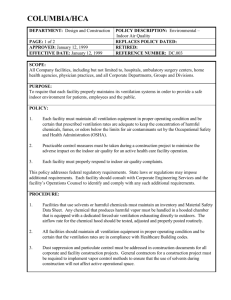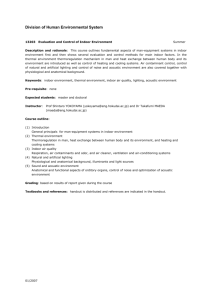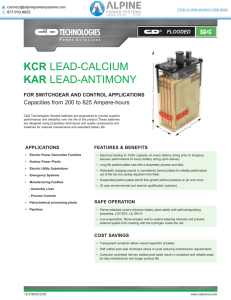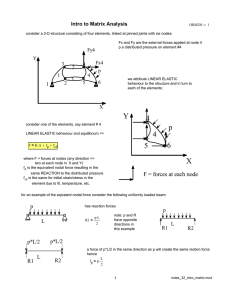Results and discussion
advertisement
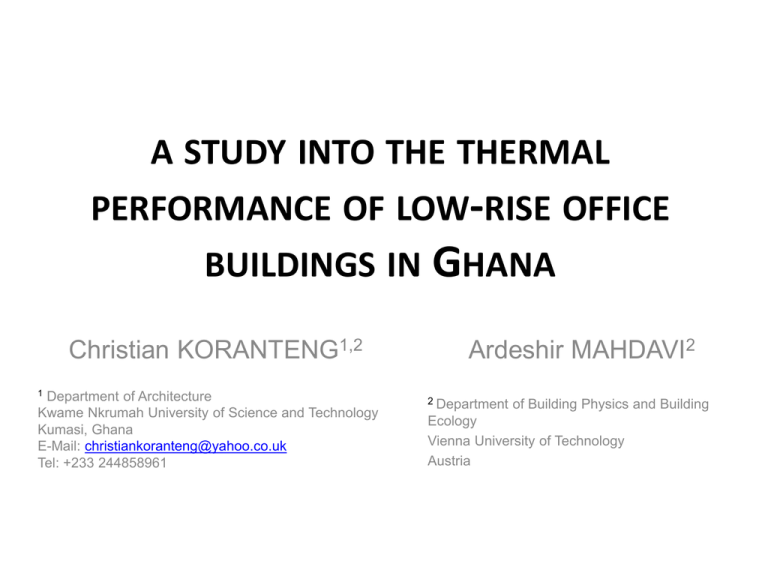
A STUDY INTO THE THERMAL PERFORMANCE OF LOW-RISE OFFICE BUILDINGS IN GHANA Christian KORANTENG1,2 1 Department of Architecture Kwame Nkrumah University of Science and Technology Kumasi, Ghana E-Mail: christiankoranteng@yahoo.co.uk Tel: +233 244858961 Ardeshir MAHDAVI2 2 Department of Building Physics and Building Ecology Vienna University of Technology Austria OVERVIEW INTRODUCTION APPROACH RESULTS & DISCUSSION Motivation Background Indoor thermal conditions Active case scenario Passive case scenario Energy use, retrofitting and CO2 emission evaluation CONCLUSION 2 INTRODUCTION MOTIVATION Increase in housing stock (42%) and growth in commercial buildings (100%) since 2000. Building designs not supported by scientific approach. Design decision making not supported by energy-efficient building design methods and technologies. 3 INTRODUCTION OBJECTIVES Long-term monitoring of the thermal conditions. The effective prediction of the buildings’ performance based on calibrated models. Simulation-based exploration to reduce cooling requirements. Assessment of carbon dioxide (CO2) emissions and retrofitting evaluation. 4 INTRODUCTION BACKGROUND . Energy use and conservation setting of environmental standards environmental control installations renewable energy alternatives building form and fabric Szokolay (2004) Thermal comfort and scales Olgyay (1953) Brooks (1963) Königsberger et al. (1974) Szokolay (2004) Mahdavi et al. (2007) Orientation and building form Salmon (1999) Szokolay (2004) Lauber (2005) 5 APPROACH BUILDINGS Selection of low-rise buildings: Schematic plans Building ANG Building CAP Building ROY Building DCD Building KCR 6 APPROACH Monitored environmental data (Temperature and relative humidity recordings) Indoor thermal conditions (plots on psychrometric charts) Calibration of the simulation application Parametric study – Active case (air-conditioning – reducing energy use) Parametric study – Passive case (no air-conditioning - reducing overheating in the buildings) Energy use, CO2 evaluation and retrofitting estimation 7 RESULTS AND DISCUSSION Monitored environmental data Comparison of mean outdoor temperature measurements at office locations (DL) with Kumasi weather station data (MET) Mean Outdoor Temperature 30 Temperature [°C] 29 28 27 26 25 24 JAN FEB MAR APR MAY JUN MET JUL AUG SEP OCT NOV DEC DL Results show a good agreement 8 RESULTS AND DISCUSSION essure: 99535.9479 Pa 12 0 13 0 11 0 Indoor thermal conditions: 10 0 10 12 0 -10 C Humidity ratio, g/kg(a) Sep Aug Nov Oct Jun Jul Dec May Mar Apr Feb % 60 40 0 20 80 80 % 60 10 % 20% Jan 0 Jan 10 40 % 10 Comfort zone 20% -10 0 -2010 -1020 0 30 Dry bulb temperature, deg C 0 0 12 0 11 0 Measured indoor eg nt % Sa tur ati o on t ati Sa tur Comfort zone 10 13 20 em Nov th 5 0 En Sep Jul Oct Aug 40 May 20 Jun Mar Apr Dec 30 Feb 20 ,d ure 60 rat k p al pe em pe rat ur y, J/ ( kg % eg C 70 a) e, d 70 13 0 30 Mean daily temperature and relative90 humidity30values 90 (averaged over all days in a month) in CAP (left) and 80 80 KCR (right) building ) (a 60 0 10 40 20 50 30 Dry bulb temperature, deg C 60 13 0 temperature and relative 12 0 humidity point to20deficient indoor thermal conditions. 11 Humidity ratio, g/kg(a) 11 0 10 Responsible factors include: 0 0 Inefficient building 90 90 10 systems (windows, fans, shades, air-conditioners, 80 80 etc) Behaviour of occupants 70 70 Unsustainable design principles (form and 40 50 60 orientation) 10 9 RESULTS AND DISCUSSION Calibration: Weather file versus measured data Calibration: Comparison of measurements and simulation Measured versus simulation indoor air temperatures (for instance) in CAP 36 34 34 32 32 Temperature [°C] 36 30 28 26 30 28 26 24 22 22 20 20 DL WF 00 :0 03 0 :0 0 06 :0 0 09 :0 0 12 :0 0 15 :0 0 18 :0 0 21 :0 0 00 :0 0 03 :0 0 06 :0 0 09 :0 0 12 :0 0 15 :0 0 18 :0 0 21 :0 0 00 :0 0 03 :0 0 06 :0 0 24 00 :0 03 0 :0 0 06 :0 0 09 :0 0 12 :0 0 15 :0 0 18 :0 0 21 :0 0 00 :0 0 03 :0 0 06 :0 0 09 :0 0 12 :0 0 15 :0 0 18 :0 0 21 :0 0 00 :0 0 Temperature [°C] Outdoor air temperature segments (WF) as against measurements (DL) at building location (KCR) Measured Simulated Measurements and simulation plots show a relatively good agreement 10 RESULTS AND DISCUSSION Parametric Study: Active case Simulated cooling loads for combined improvement scenarios. Total cooling load (%) Reduction (%) CAP 78.5 21.5 KCR 65.8 34.2 ANG 74.7 25.3 ROY 71.1 28.9 DCD 80.3 19.7 Efficient Windows Attic Floor Insulation (on Ceiling) Natural Ventilation Efficient Electric Lighting Efficient and combined improvement scenarios (such as better windows, natural ventilation, and efficient electrical lighting) appear to have a synergistic effect on cooling loads (20 to 35% reductions). 11 RESULTS AND DISCUSSION Parametric Study: Passive case Mean overheating (OHm in K) and fraction of time (FOT in %) with indoor conditions within the comfort zone (from 8 am to 5 pm, assumed indoor air speed 1.0 m.s-1) (BC: Base case, PC: Passive case-improvements) Building CAP KCR ANG ROY DCD BC FOT [%] 25 30 20 12 43 PC OHm [K] 4.4 4.2 5.1 6.0 3.8 FOT [%] 77 73 65 72 68 OHm [K] 1.8 2.0 2.4 2.0 2.1 Mean overheating could be reduced from ca. 5 down to ca. 2 K. A FOT of 65 to 77% was calculated (for 1.0 m.s-1). Fan induced ventilation of 1.0 m.s-1 (awareness) would probably be needed in free-running office buildings in Kumasi. More stringent performance objectives would require mechanical cooling. 12 RESULTS AND DISCUSSION Parametric Study: Passive case PMV (predicted mean vote) and PPD (predicted persons dissatisfied)(in %) for all buildings (BC: Base case, PC: Passive case-improvements) Building CAP KCR ANG ROY DCD BC PMV 2.8 2.8 3.1 3.3 2.6 PC PPD 93.5 91.6 95.0 97.1 87.5 PMV 1.6 1.6 1.8 1.6 1.7 PPD 55.5 54.5 64.3 56.3 58.2 Combined measures (particularly the use of natural ventilation) could significantly reduce PPD. The results are however very high (55 to 65% PPD). Estimated PMV and PPD values show improvements by adapting the PC scenario 13 RESULTS AND DISCUSSION Energy use, CO2 reduction and retrofitting estimate (payback time): All based on the comparison of the BC and CI scenarios. Assumptions made: unit cost of electricity in Ghana = 0.12 € per kWh, system efficiency for the split air-conditioning units = 2.6, CO2 emission = 0.238 kg.kWh-1 Building CAP KCR ANG ROY DCD Total Building CAP KCR ANG ROY DCD Energy cost saving [€] 7,937 13,076 4,760 19,815 2,865 48,454 Energy saving [kWh] 66,144 108,966 39,668 165,126 23,878 403,783 Retrofit expenses [€] 43,239 41,465 14,554 233,706 20,876 CO2 reduction [kg] 15,742 25,934 9,441 39,300 5,683 96,100 Payback time (years) 5.4 3.2 3.1 11.8 7.3 14 RESULTS AND DISCUSSION Energy use, CO2 reduction and retrofitting estimate (payback time): Efficient and combined improvement scenarios (better windows, natural ventilation, and efficient electrical lighting) again led to reductions in the energy use of the buildings (in average 27% and 3,000 to 20,000€ annual energy savings) CO2 emissions could be reduced by about 6 to 40 tons per building (in all ca 100 tons) through more energy efficient building performance. Mean CO2 reductions of 27%. CO2 voucher value rather small (ca. € 17 per tons of CO2). The payback times calculated for the amortization of building retrofit costs can be considered reasonable (3 – 12 years). 15 CONCLUSION . The measured temperature and relative humidity values in the offices point to deficient thermal comfort conditions. However, occupants' adaptation capability may have been underestimated. Combinations of better windows, natural ventilation, and efficient electrical lighting have a synergistic effect on cooling loads, energy use and CO2 emissions (20 to 35%). The payback times calculated for the amortization of building retrofit costs can be considered reasonable (3 –12 years). The use of natural ventilation (1.0 m.s-1) could increase the fraction of time (FOT) in which thermal indoor conditions are in the comfort zone (65 – 77%). These positive measures, when implemented, have the potential to contribute positively to the energy situation in Ghana. 16 THANK YOU 17
